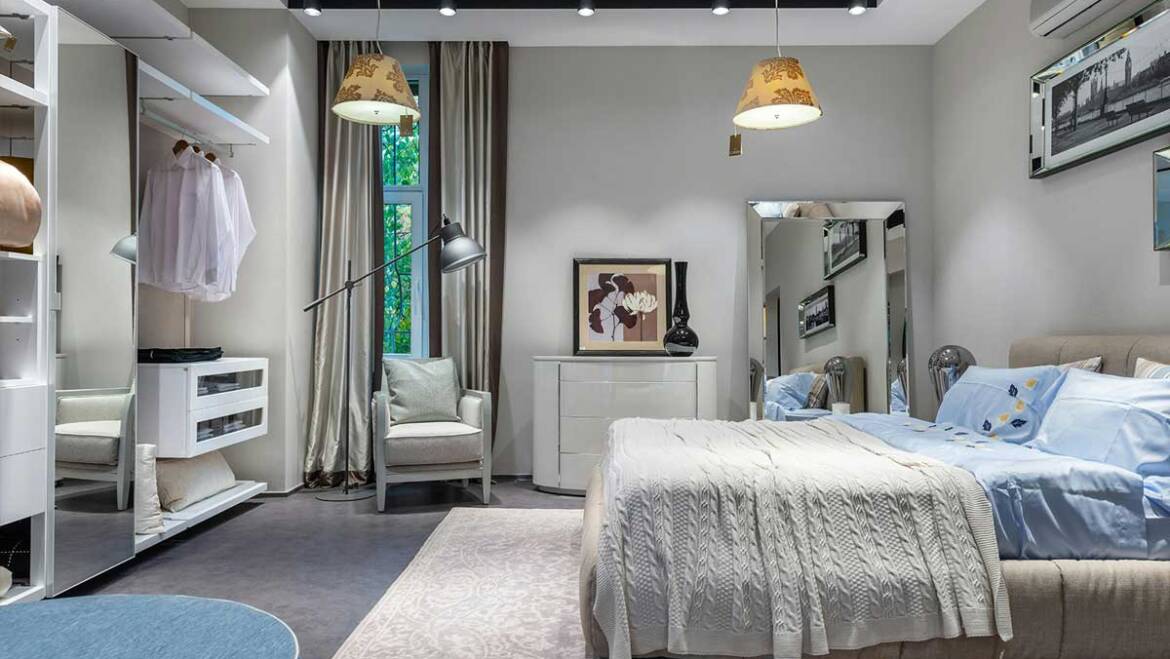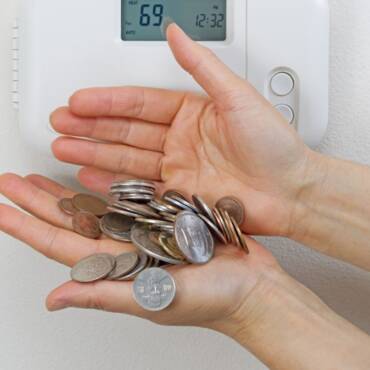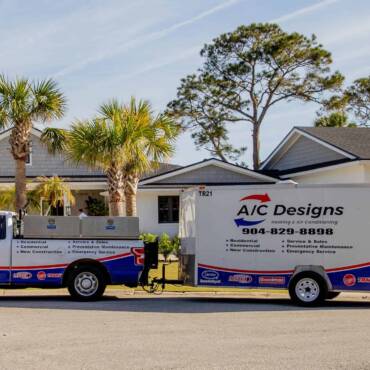Reverse cycle air conditioners are versatile climate-control systems that heat and cool using a single unit. They work by transferring heat utilising a refrigeration cycle: in cooling mode, they absorb heat from inside the home and release it outside, while in heating mode, they extract heat from the outside air—even in cold weather—and bring it indoors by reversing the flow of refrigerant. This efficient process allows a single system to both heat and cool a space as needed.
This makes them up to 600% efficient, meaning they can deliver up to six times more heating or cooling energy than the electricity they consume. This high efficiency translates into significant energy savings and provides both heating and cooling for year-round comfort¹.
Types of Reverse Cycle Air Conditioners: Ducted vs. Split (and Multi-Split)
Ducted Reverse Cycle Air Conditioner
How they work
These systems feature a central outdoor compressor and an indoor fan coil, distributing conditioned air through concealed ducts into each room via vents. Installation usually requires space in ceilings or floors.
Advantages of a Ducted Reverse Cycle Air Conditioner:
- Whole-home comfort & zoning: You can heat or cool multiple rooms simultaneously—and even set different temperatures by zone to increase efficiency.
- Discreet appearance: Only vents are visible—no wall-mounted units cluttering your aesthetic.
- Quiet operation: Since equipment is usually tucked away, living spaces stay calm and peaceful.
- Higher property value: A well-installed ducted system can enhance a home’s appeal.
Challenges of a Ducted Reverse Cycle Air Conditioner:
- Potential energy waste if poorly zoned: Cooling the entire house unnecessarily can increase energy bills.
- Installation complexity: Not all homes can accommodate ductwork, especially older designs or those without a roof or floor cavity space. However, there are small ducted systems are available.
- Maintenance: Duct cleaning and system servicing require professional oversight.
Reverse Cycle Split System Air Conditioner
How they work
A wall-mounted indoor unit (the evaporator and fan) and an outdoor compressor are connected via refrigerant piping. These units target individual rooms or zones.
Advantages of a Reverse Cycle Split System Air Conditioner:
- Lower cost & faster install: Split systems are typically more affordable to buy and quick to install, often completed in one day.
- Flexible coverage: Perfect for cooling/heating select spaces. You only run units in rooms you use, enhancing energy savings.
- Energy-efficient per room: Especially when multiple units aren’t needed.
- Individual control: Each unit can operate independently, allowing tailored comfort.
Challenges of a Reverse Cycle Split System Air Conditioner:
- Aesthetic intrusion: Indoor units are visible on walls and may not be suitable for every decor.
- Uneven temperatures: Without careful placement, some rooms may stay warm while others get cold.
- Cost stacks up if many rooms are used: Installing several units can become expensive and increase running costs.
Multi-Split System Air Conditioner
How they work
Multiple indoor units (in different rooms) connect to a single outdoor unit. It’s essentially a hybrid of split and ducted systems..
Advantages of a Multi-Split System Air Conditioner:
- Room-by-room freedom: Individual control over multiple areas without multiple outdoor units.
- High efficiency with inverter tech: Adapts energy use to demand, translating to lower energy bills.
Trade-offs to a Multi-Split System Air Conditioner:
Visible indoor units: While less intrusive than multiple split systems, you still have wall-mounted units.
System design must be well planned for optimal performance and aesthetics. Thankfully, our Glow Reverse Cycle Air Conditioner technicians have experience in planning for multi-split systems.
Energy Efficiency, Cost and Sustainability Insights
One of the biggest advantages of reverse cycle air conditioning—whether ducted or split—is its outstanding efficiency compared to traditional heating and cooling methods. Instead of generating heat, these systems transfer it, which means they can deliver up to six times the energy they consume. This level of efficiency makes reverse cycle systems one of the most cost-effective ways to maintain comfort throughout the year.
Recent studies in Victoria highlight just how significant the savings can be. Households that switch from gas heating to electric reverse cycle systems, particularly split units, can save anywhere from $999 to $2,215 annually. In fact, the reduced running costs can often recoup the expense of removing old gas systems within just five to ten months2. For many families, this shift not only lowers bills but also reduces reliance on gas, which has environmental benefits.
Another factor to consider is energy loss through ducts. While ducted reverse cycle air conditioning provides whole-home comfort, it can lose up to 30% of the conditioned air through the ductwork if it isn’t properly sealed or insulated. A reverse cycle split system air conditioner avoids this issue entirely, making it particularly efficient for heating and cooling single rooms or smaller spaces.
Technology is also driving improvements in sustainability and efficiency. Modern inverter-driven systems adjust power output to match demand, avoiding the stop-start inefficiencies of older models. Even more advanced is Variable Refrigerant Flow (VRF) technology, which can reduce energy use by as much as 55% compared to conventional systems. When comparing models, checking performance measures such as the Coefficient of Performance (COP) or Energy Star Ratings can help you identify the most efficient options. Some high-quality split systems now achieve COP ratings above 4.0
Comparing Suitability
| Home Type & Needs | Recommended System | Why It Works |
| Large home, multiple occupants | Ducted (with zoning) | Whole-home comfort, hidden design, zoned usage |
| Medium-sized home, budget-conscious | Multi-Split | Flexible rooms coverage |
| Apartments or single room focus | Split system (1–2 units) | Efficient for spots |
| Sustainability-focused occupants | Modern inverter split/ducted, potentially with solar or VRF | High COP, low emissions, eco-friendly |

Which Reverse Cycle Air Conditioner is best for your home?
Choosing between a ducted reverse cycle air conditioner or a reverse cycle split system air conditioner ultimately comes down to your home, lifestyle, and budget. A ducted reverse cycle air conditioner is ideal if you are after seamless, whole-home comfort and a discreet look, while a reverse cycle split system air conditioner or multi-split systems are a smart choice for more targeted, cost-effective climate control. Both options are far more efficient than traditional gas heating, with modern inverter technology and zoning capabilities further improving performance and reducing energy use.
By considering how you use your spaces and what level of flexibility or efficiency you need, you can select a system that delivers comfort all year round—while keeping energy bills and environmental impact in check.
References
- https://www.agl.com.au/discover/saving-energy/air-conditioner-efficiency
- https://www.theguardian.com/environment/2024/oct/16/reverse-cycle-air-conditioning-victoria-cut-energy-bills-climate-impact?
Whether you require installation, repair, or maintenance, our technicians will assist you with top-quality service at any time of the day or night. Take comfort in knowing your indoor air quality is the best it can be with MOE heating & cooling services Ontario's solution for heating, air conditioning, and ventilation that’s cooler than the rest.
Contact us to schedule a visit. Our qualified team of technicians, are always ready to help you and guide you for heating and cooling issues. Weather you want to replace an old furnace or install a brand new air conditioner, we are here to help you. Our main office is at Kitchener but we can service most of Ontario's cities
Source link



